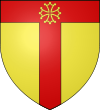- Tarn (department)
-
Tarn — Department — 
Coat of armsLocation of Tarn in France Coordinates: 43°49′N 02°12′E / 43.817°N 2.2°ECoordinates: 43°49′N 02°12′E / 43.817°N 2.2°E Country France Region Midi-Pyrénées Prefecture Albi Subprefectures Castres Government – President of the General Council Thierry Carcenac Area1 – Total 5,758 km2 (2,223.2 sq mi) Population (2007) – Total 369,501 – Rank 65th – Density 64.2/km2 (166.2/sq mi) Time zone CET (UTC+1) – Summer (DST) CEST (UTC+2) Department number 81 Arrondissements 2 Cantons 46 Communes 324 ^1 French Land Register data, which exclude estuaries, and lakes, ponds, and glaciers larger than 1 km2 Tarn (Occitan: Tarn) is a department of 5,758 km2 in the Midi-Pyrénées region in the southwest of France, named after the Tarn River. It was formed in 1790 of the three dioceses of Albi, Castres and Lavaur, belonging to the province of Languedoc. In 1906, the population was 330,533. In 1999, it stood at 343,402.
Of particular note in the department are Albi (the capital), Castres, Gaillac, Lavaur, Mazamet and Cordes.
Other places of interest are:
- Burlats, which has ruins of an old church and chateau
- Lisle-sur-Tarn, a bastide with a church of the 14th century
- Penne which has ruins of a fine medieval château.
Contents
History
Tarn is one of the original 83 departments created during the French Revolution on 4 March 1790, through application of the Law of 22 December 1789. It was created from part of the former province of Languedoc, and comprised the dioceses of Albi and Castres (which found themselves merged in 1817).
By the law of 28 Pluviôse, Year 5, the departments of Hérault and of Tarn exchanged the canton of Anglès (which had been part of the diocese of Saint-Pons, but which has remained in Tarn) for that of Saint-Gervais-sur-Mare (which had been part of the diocese of Castres, but which today remains in Hérault ).
Landscapes
Tarn's three principal ranges lying to the south-east are: the Mountains of Lacaune, the Sidobre, and the Montagne Noire, belonging to the Cevennes. The stony and wind-blown slopes of the firstnamed are used for pasture. The highest point of the range and of the department is the Pic de Montalet (about 4150 ft.); several other summits are not much short of this. The granite strewn plateaux of the Sidobre, from 1600 to 2000 ft high, separate the valley of the river Agout from that of its western tributary, the river Thoré. The Montagne Noire, on the southern border of the department, derives its name from the forests on its northern slope, and some of its peaks are from 3000 to 3500 ft high.
The limestone and sandstone foot-hills are clothed with vines and fruit trees, and are broken by deep alluvial valleys of particular fertility. With the exception of a small portion of the Montagne Noire, which drains into the river Aude, the whole department belongs to the basin of the Garonne. The eastern portion of the department has the climate of Auvergne, the severest in France, but that of the plain is Girondin.
Tarn is bounded north and east by Aveyron, southeast by Hérault, south by Aude, southwest and west by Haute-Garonne, northwest by Tarn-et-Garonne. The slope of the department is from east to west, and its general character is mountainous or hilly.
 This article incorporates text from a publication now in the public domain: Chisholm, Hugh, ed (1911). Encyclopædia Britannica (11th ed.). Cambridge University Press.
This article incorporates text from a publication now in the public domain: Chisholm, Hugh, ed (1911). Encyclopædia Britannica (11th ed.). Cambridge University Press.See also
- Cantons of the Tarn department
- Communes of the Tarn department
- Arrondissements of the Tarn department
- Tourism in Tarn
References
External links
- (French) Photos of the Tarn
- (English) Official Tourist Board website
- (French) Prefecture website
- (French) General council website
Categories:
Wikimedia Foundation. 2010.

